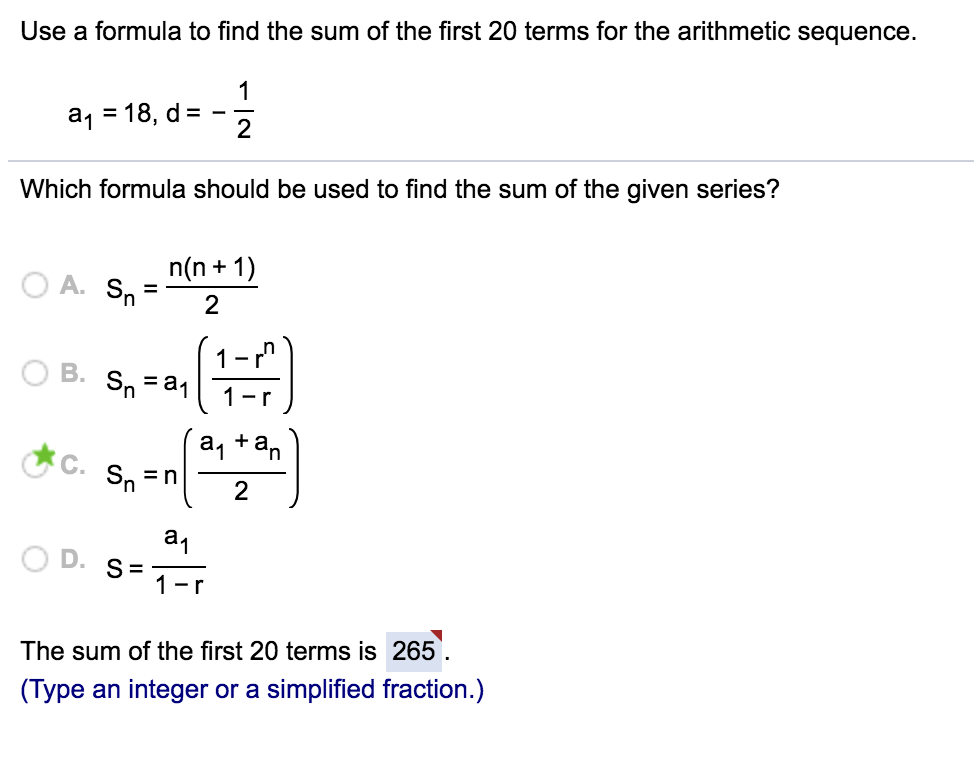


The sum of the first \(n\) terms of an arithmetic sequence when the \(n^\] \(\therefore S_n = 440\).Since there are a total of 5 rows, n is 5. Thus, the sum of these terms is n ( a n + a 0) 2, where n is the total number of terms. Sequences of numbers that follow a pattern of adding a fixed number from one term to the next are called arithmetic sequences. a n, then we can add the first and last term, the second and second last term, etc., to quickly find the sum based on the number of terms. The last term in the sequence is 5 (5 dark green triangles in the last row. If we have the sequence a 0, a 0 + x, a 0 + 2 x. The first term in the sequence is 1 (1 dark green triangle in the first row. To use the formula we need the first term, the last term and n.
#SUM OF ARITHMETIC SEQUENCE HOW TO#
We will see how to derive the sum of arithmetic sequence formula.Ĭonsider an arithmetic sequence whose first term is \(a_1\) or \(a\) and the common difference is \(d\). The sum the first five rows of dark green triangles is represented by the symbols below. How to Find the Sum of an Arithmetic Sequence?Īn arithmetic progression is a sequence where the differences between every two consecutive terms are the same. We use the same logic to find the sum of the arithmetic sequence formula. Thus, the sum of all terms of this sequence is:

#SUM OF ARITHMETIC SEQUENCE SERIES#
Finding the Sum Using a 1, a n, and n Worksheet 2 Provide a comprehensive review to high school students with this sum of a finite arithmetic series worksheet. We can see that in the sequence \(1,2,3.,100\), there are \(50\) such pairs whose sum is \(101\) Use the formula S n (n/2) (a 1 +a n) and substitute the appropriate terms to find the sum of the given finite series. Well, he noticed that terms equidistant from the beginning and the end of the series had a constant sum equal to \(101\) This boy was the great German mathematician Carl Friedrich Gauss. One boy shouted out the answer \(5050\) while the other students were still in the initial steps of calculating the sum. The students were struggling to calculate the sum of all these numbers. Dividing both sides by 2 leads us the formula for the n th partial sum of an arithmetic sequence: Sn n(a1 + an) 2 Use this formula to calculate the sum of the first 100 terms of the sequence defined by an 2n 1. The teacher asked her students to add all the numbers from \(1\) up to \(100\) In Germany, in the 19 th century, a Math class for grade 10 was going on. It contains well written, well thought and well explained computer science and programming articles, quizzes and practice/competitive programming/company interview Questions. You can also find the sum of arithmetic sequence worksheets at the end of this page for more practice. #n = 8#-># Therefore, the series has 8 terms.In this mini-lesson, we will explore the sum of an arithmetic sequence formula by solving arithmetic sequence questions. #t_n=15# (last term of the sequence), a = 1 (first term), d = 2 (difference between terms) and solve for n like so: To do so, you must start with the arithmetic sequence formula: You would do the exact same process, but you would have to SOLVE for "n" (number of terms) first. The sum, of the first terms of any arithmetic sequence is written as To find the sum by merely adding all the terms can be tedious. As with the general sequences, it is often useful to find the sum of an arithmetic sequence. Say you wanted to find the sum of Example B, where you know the last term, but don't know the number of terms. Find the Sum of the First n Terms of an Arithmetic Sequence. #S_20=820#-># Therefore the sum of the series is 820! Sub in all the known values: n = 20 (20 terms), a = 3 (first term is 3), and d = 4 (difference between terms is 4). Now, we'll find the sum of Example A, and because we don't know the last term, we have to use equation 2. The second equation can be used with no restrictions. Note: The first equation can only be used if you are given the last term (like in Example B). To start, you should know the following equations: We can find the sum of an arithmetic sequence or the value of an arithmetic series by finding the average of the first and the last term then multiplying the result by the number of terms. + t_20#Įxample B: #1 + 3 + 5 + 7 + 9 + 11 + 13 + 15# The only difference between arithmetic sequences and series is that arithmetic series reflects the sum of an arithmetic sequence. To aid in teaching this, I'll use the following arithmetic sequence (technically, it's called a series if you're finding the sum):Įxample A: #3 + 7 + 11 + 15 + 19.


 0 kommentar(er)
0 kommentar(er)
